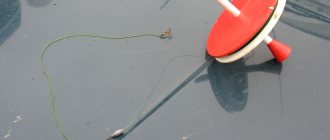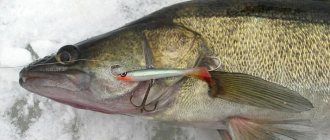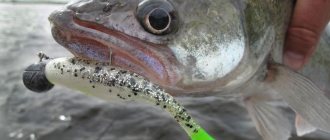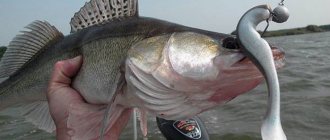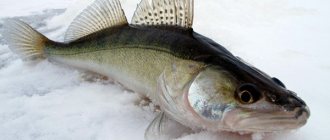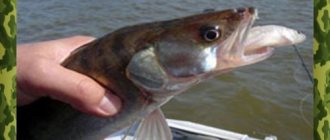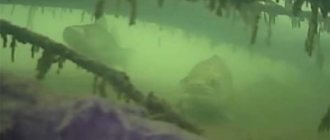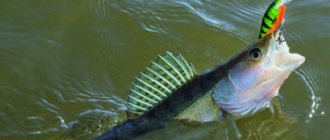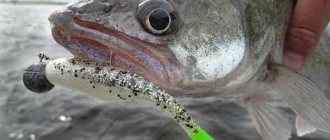Yuri 05.10.2020 258
Fishing mugs are also floating girders. This unique method of catching predatory fish was described in his works by the Russian zoologist and fishing enthusiast Leonid Pavlovich Sabaneev. He argued that fishing with mugs can only be organized in quiet river creeks and ponds, and their use in large water areas is not justified. He explained this by saying that the mugs could float very far.
A lot of time has passed since this version was published. Many fishermen have repeatedly refuted in practice the researcher’s statement about the impossibility of fishing with circles in large expanses of water. This especially applies to fishing for pike perch using floating girders.
Fishing for pike perch with mugs most often takes place in large water areas: wide rivers, lakes and reservoirs. It is this fascinating method of catching a predator that will be discussed in this article.
Setting up circles for catching pike perch
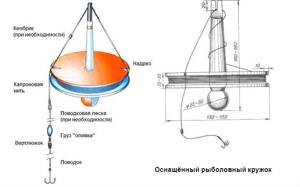
The thickness of the disc does not exceed 40 mm. For production, light, relatively strong materials that do not sink in water are used:
- Pine.
- Spruce.
- Linden.
- Expanded polystyrene.
- Dense foam.
Wooden products are treated with waterproof paints and drying oils. The disk must be painted with bright paint: yellow or red paint is applied to the surface part. The underwater part is painted white. To wind the fishing line along the end, you need to make a groove.
Preparing gear
Mugs
The circle is designed for catching predatory fish with live bait on lakes and rivers with a slow current, and the most preferred places are bays and creeks, since in a fast current, even the most experienced fisherman may not have enough skill to control the boat to “serve” all the circles.
Structurally, the circle is a flat disk with a diameter of approximately 15 cm and a thickness of 25–30 mm. For production, either soft wood species (pine, spruce, linden) or hard foam are used. Naturally, to prevent exposure to water, the mugs are painted with at least two layers of waterproof paints.
The color of the circles plays another important role - it is an indicator of its behavior, which often indicates bites from predatory fish. The lower part is painted white , and the upper part is painted red, which makes the circle visible on the water even in light wave conditions.
A groove about 15 mm deep is made at the end of the circle for winding a supply of fishing line. To fix the fishing line in the circle, small cuts are made on its upper part on diametrically opposite sides.
A peg is inserted into the center of the circle , which has a diameter of about 20 mm. It is best to fix the peg in the hole using a balsa wood insert.
The peg should have a length at the top approximately equal to the diameter of the disk - that is, 150 mm. The upper part has a cut for fixing the fishing line and is painted in the same color as the disk itself - red or orange.
The lower part, which has a pear-shaped thickening , is painted white, but longitudinal dark stripes are made on it in order to notice from a distance the rotation of the circle when unwinding the fishing line. This most often happens after the fish has grabbed the bait.
Line, leashes, sinkers, hooks
It is preferable to use a braided cord as a fishing line , since it is less springy and will not come off in rings from the circle, which can cause tangling, but it is better to make a leash from monofilament of the same diameter as the cord; the use of metal leashes is impractical: they only scare away pike perch and interfere with the play of live bait. The length of the cord (fishing line) wound around the circle should exceed the expected fishing depth by 6–8 meters.
This will allow the predator to grab and swallow the prey without feeling the resistance of the mug, because it is this that can cause the pike perch to simply spit out the bait .
The length of the leash is 40–60 cm ; it is better to attach it to the main cord (line) through a carabiner with a swivel, which will ensure free movement of the bait. It is better to use a weight in the form of an olive weighing 9–15 grams; you can fix it on the fishing line using a bead.
Are you interested in a fishing muzzle? Our article will tell you more about this.
In this article we will talk about the cost of a fishing license.
To catch pike perch with circles, it is best to use single hooks No. 9–13, double or triple hooks No. 5–9 . It is better to attach the hooks to the fishing line using a winding ring with a diameter of 4–5 mm, which will allow you to quickly change hooks and will facilitate the free movement of baitfish.
leashes with hooks in advance, winding them on a reel, so that when fishing you can fully concentrate on the fishing process itself and not be distracted by making gear.
Necessary equipment
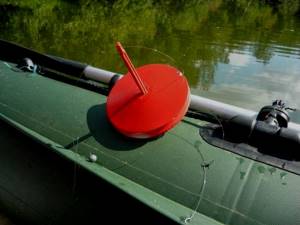
A boat is required for fishing, especially if there is a current. Equipment for pike perch circles:
- Pin. A mast is placed in the center of the structure. This is an ordinary peg made of wood, in the upper part of which there is a cut for fixing the fishing line.
- Fishing line. You can use braided wire, although opinions vary. As for the parameters: line thickness is 0.35-0.4 mm. Line lengths must be kept in reserve. The total length of the fishing line should be 5-10 meters greater than the maximum depth in the intended fishing location.
- Leash. When fishing for pike perch, it is not advisable to use metal leashes. They can serve as an additional irritant for the fanged inhabitant of the depths. A regular fishing line with a diameter of 0.3 mm will be sufficient. A metal leash is installed only for frequent pike attacks.
- Swivel. An important element prevents twisting of the equipment with live bait. Allows you to quickly change the leash with a carabiner.
- Hooks. There are different options here, depending on the fishing conditions and the preferences of the fisherman. More often, doubles are used, which perfectly pierce the bony mouth of pike perch.
Recommended reading: How to catch bream on the river in winter
On a note! The hooks used may vary in size. Live bait is placed on the small one, and the larger one is pressed against the back of the fish, preventing the predator from pricking itself ahead of time.
Fishing stages
The main guarantee of a good catch is also a clear distribution of the process, so all actions must be performed in the following sequence:
- First, a place for fishing is selected.
- Then the buoys are placed depending on the depth of the reservoir. To do this, you must always have a depth gauge with you.
- After the buoys are placed, the circles are placed.
- Next, it is best to sail away from the circles at a decent distance and watch the circles.
- As soon as the circle turns over, you need to swim to it from the leeward side and hook the fish.
- Once the fish is caught, it must be killed. A hammer or knife is used for this.
To determine which baitfish the pike perch prefers, it is best to place a different bait on each circle. This is the only way to accurately understand zander’s preferences. As practice shows, many fishermen recommend using bait such as crucian carp, roach or bleak.
Fishing times and places

During the autumn zhora, the fanged can hunt around the clock, taking short breaks.
Ambush sites can include holes, abnormal changes in the bottom of the reservoir, fallen trees and snags.
Note! The fanged fish almost always accompanies schools of bream. We are talking about autumn fish activity. During Indian summer, bream can approach the coastline, where they play in the upper layers of water.
This fact, together with other positions, can serve as a starting point for catching a predator with mugs.
Catching pike perch with live bait using circles will be successful when placing floating traps:
- In the bays.
- On rivers with moderate currents.
- In the lakes.
The use of the gear in question is very problematic on fast rivers. The current creates additional difficulties not only for beginners, but even for experienced anglers.
Boat and equipment for fishing for pike perch with mugs
Before leaving the shore, you must prepare all the supplies in advance. You need a small boat with oars. At the same time, there must be enough space in the boat to accommodate all the equipment, since fishing with mugs is a technically complex procedure. Every thing should be in its place. A bucket of live bait and cages are next to your feet. The mugs are on the side of the boat. You should not place more than 15 circles, so this amount will be enough. The landing net and spare live bait are located at the back of the boat. You should have an extractor with a hammer at hand.
Fishing technique

The fanged one can be found on the edges, in the bottom layers of water: the live bait should be 500-700 mm from the bottom. When fishing for pike perch at night, it is better to use anchor circles when choosing edges.
The leash is fixed at a certain level: 400-600 mm. The live bait is attached to the lip: the sinker goes to the bottom. The free line is wound up and fixed on the pin of the circle.
When a predator attacks, the circle turns over. A white disc appears on the surface of the water. If you use an anchor circle, it is better to use a sinker weighing 200-400 grams.
During zhora, pike perch is active, therefore, its attack is sharp. The circle instantly turns over. There is no need to rush to hook: the bait may come out of the mouth. A pause is necessary during which the fishing line will gradually unwind; during this time the fanged fish can pull off 1.5-3 meters of fishing line. Only then is a sweeping, energetic sweep done.
We recommend reading: Winter pike fishing with girders
Lures
And of course, what kind of gear is there for catching pike perch without well-chosen baits. In this regard, I want to say that during night fishing for pike perch, in shallow water, there is nothing better than wobblers 3-5 cm long. It doesn’t even matter what color your wobbler is, the main thing is that it is simple, without any blades for half a fish, oblong bait. By the way, wobblers are simply great during slow night fishing, but are absolutely ineffective during the daytime, when the pike perch moves to a depth of 7-10 meters in the reservoir.
During the day, silicone baits have proven themselves well. Moreover, just like with wobblers, this part of the tackle is not critical to color. The shape of the bait is important here. For example, in my case, the Profi Blinker and Predator vibrating tails from Manns worked well.
Practical advice
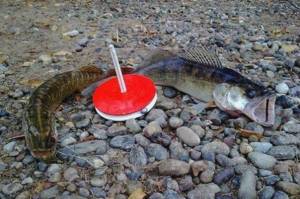
The predator has favorite ambush and hunting spots. It is advisable to record the place where the bite occurred on GPS.
When catching pike perch, it is better to use live bait that lives in a given pond or river. The fanged one is naturally endowed with an excellent sense of smell and unfamiliar smells can alert him. He will not completely refuse live bait, but the quality and quantity of bites may be greatly reduced.
For short-term fishing, you can use any small fish. If you need to leave the gear for a long time, it is better to use the most tenacious perch as live bait.
When hunting for a predator in a “snagged” reservoir, you need to leave a large supply of fishing line. You must not allow it to completely unwind, otherwise the pike perch may get the tackle under the snag and get confused. The working part of the fishing line is measured based on the depth of the promising location.
Important. Although pike perch prefers to hunt in the lower layers of water, you need to understand that the bottom is an additional obstacle to the equipment. To prevent the live bait from clinging to the bottom, it is raised by 50-70 cm. If there are a lot of snags in the area, it is better to raise the equipment even higher.
When a predator bites, the fishing line that is in the gaps should come off easily without creating tension. Otherwise, the fanged one will sense the catch and spit out the bait. When fishing for a trophy, you shouldn’t take risks; it’s better to use a fishing landing net.
September is characterized by increased activity of the predator, focusing on the weather and water level in the reservoir. You can meet the fanged robber at dawn, in calm water. In September (second half of the month), pike perch has a serious competitor - pike. Many people switch to catching the toothy robber.
If we generalize the fishing period, we can talk about the possible use of circles until the first ice appears.
Finally
Hunting for pike perch on mugs requires careful preparation. It takes a lot of time and physical effort. It's one thing to place fighters in positions. Another thing is to constantly monitor them and move around, raising the disks, checking the bait.
Recommended reading: How to catch roach with a float rod
But it is movement that creates drive. When you're doing gambling, you don't notice the time that flies by in an instant. We recommend trying the not-yet-massive hunting of fanged animals using discs and live bait. It’s better to go out on the water for the first time accompanied by an experienced assistant.
A little later, we will consider in detail the issue of specific fishing for pike with mugs. Follow the post, good luck!
